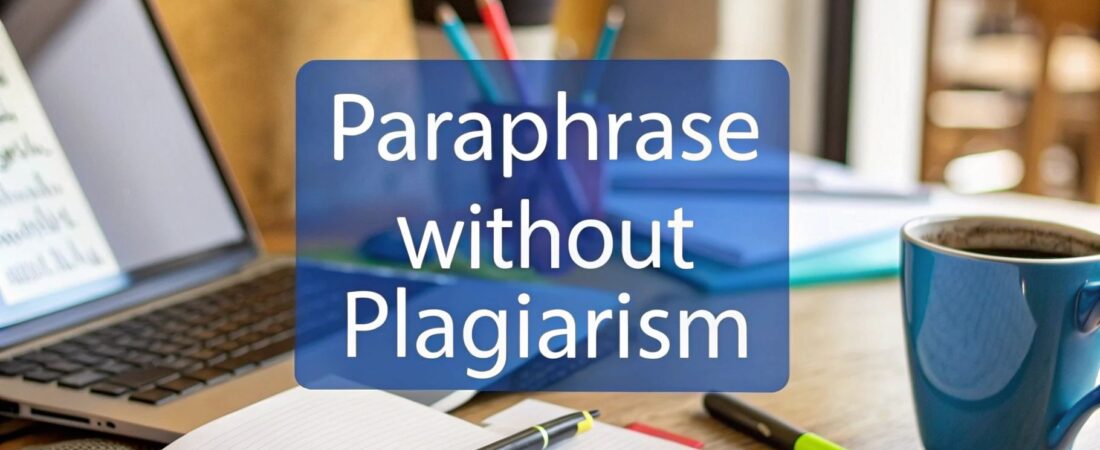Why Every Writer Needs Bulletproof Paraphrasing Skills
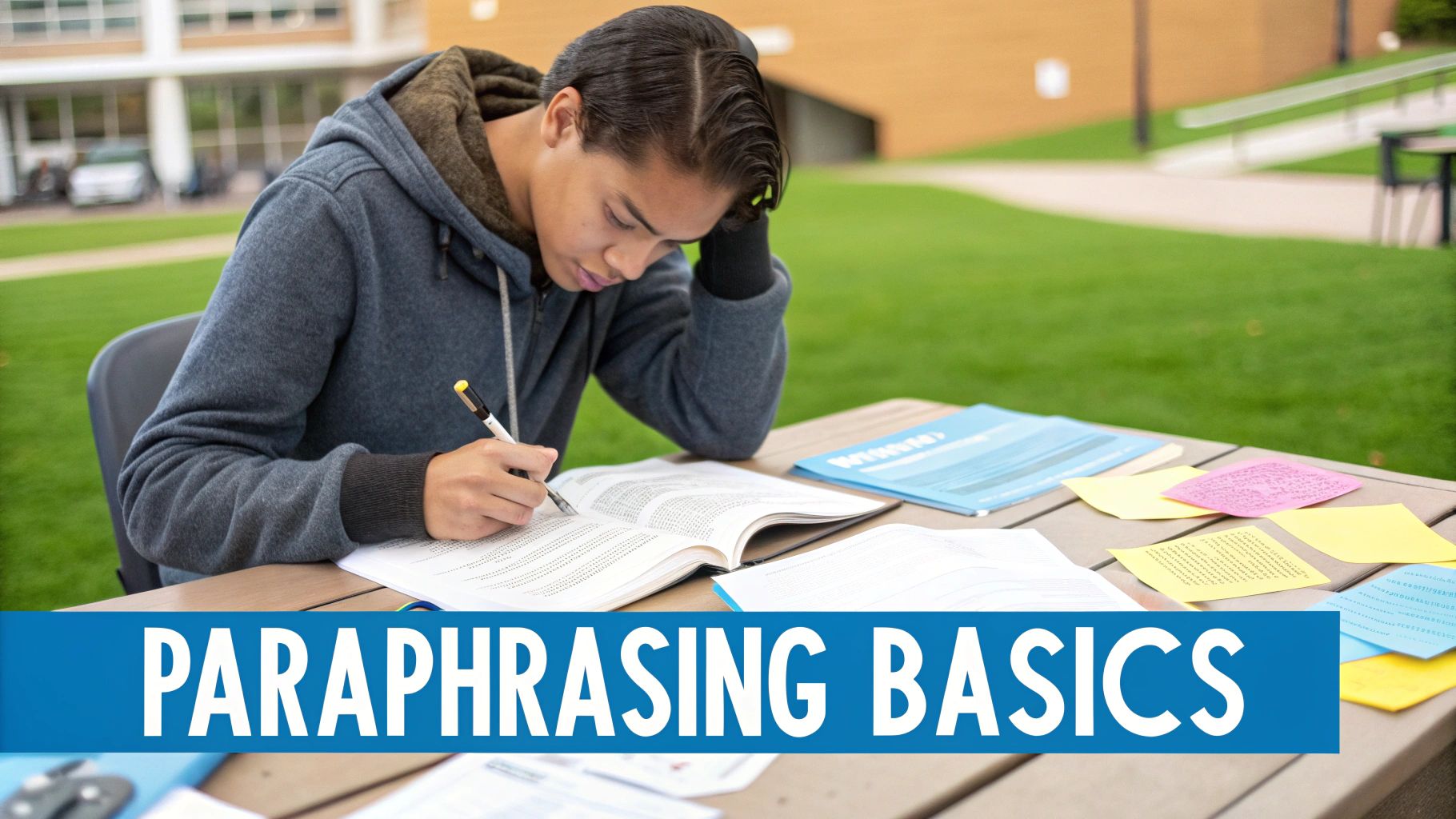
Let's be honest, writing today comes with its own set of pressures. Whether it's a college paper, a blog post, or marketing copy, your credibility depends on ethically using sources. I've known writers whose reputations took a serious hit because of accidental plagiarism. The rules have changed, and simply swapping out a few words isn't enough anymore.
Sophisticated plagiarism checkers like Grammarly and Turnitin are everywhere now. Even writers with the best intentions can get caught. I had a friend who almost failed a class because she thought restructuring a sentence was all it took to paraphrase. She missed the crucial part – citing the original source of the idea. These systems are getting unbelievably good at picking up on similarities, so understanding how to paraphrase correctly is more vital than ever. Universities and businesses are investing heavily in this technology – they mean business.
This investment highlights how much emphasis is being placed on original content. Think about it: businesses want their content to be unique and engaging. Duplicate content hurts everyone involved. In academia, originality is the foundation of intellectual property and progress. Paraphrasing well isn’t just about avoiding trouble; it's about showing you truly understand the material. This means absorbing information, processing it, and presenting it in your own voice. It's about contributing something new, not just repeating what's already out there.
This increasing need for original content is reflected in the growth of the plagiarism detection market. It generated USD 4,136.7 million in 2024 and is expected to hit USD 7,588.1 million by 2030. That's a massive jump and shows just how important solid paraphrasing skills are. Dive deeper into plagiarism detection market trends.
Developing strong paraphrasing skills shouldn’t be about fear. It’s about gaining confidence in your writing. It’s about laying down a strong base of ethical writing that will help you throughout your entire career. It’s about taking control of your voice and adding something truly original to the world.
Consequences of Plagiarism Across Different Contexts
To understand the importance of good paraphrasing practices, let’s look at the potential fallout from plagiarism in different scenarios. The table below outlines some key differences.
| Context | Immediate Consequences | Long-term Impact | Detection Likelihood |
|---|---|---|---|
| Academic | Failing grade on assignment, suspension, expulsion | Damaged academic record, difficulty gaining admission to other institutions | High, with tools like Turnitin widely used |
| Professional | Retraction of publication, loss of job, legal action | Damage to professional reputation, difficulty finding future employment | Moderate to High, depending on the industry and publication standards |
| Digital Content (Blogs, Websites) | Lower search engine rankings, loss of credibility, legal action | Damage to website reputation, reduced traffic and revenue | Moderate, with plagiarism checkers becoming more sophisticated |
As you can see, plagiarism carries serious consequences, making ethical paraphrasing a must-have skill.
The Hidden Plagiarism Traps Most Writers Miss
Let's talk plagiarism. It's trickier than you might think. Sure, everyone knows copying and pasting is wrong. But plagiarism comes in sneakier forms, too – the kind that can trip up even seasoned writers.
These gray areas are the real danger zones. One big misconception? That swapping a few words is enough to avoid plagiarism. Absolutely not. Real paraphrasing means grasping the central idea and putting it in your own words. It's not a synonym-shuffling game; it's about truly transforming the concept.
Think about it: You're paraphrasing a sentence about social media's impact on teens. Instead of just swapping "impact" for "effect" and "teenagers" for "adolescents", look at the bigger picture. Maybe zero in on one specific aspect, like how social media affects their self-esteem or social interactions. That shows true understanding.
Another trap? Skipping the citation even when you paraphrase. This is more common than you'd think, especially when juggling multiple sources. It's easy to think, "I rewrote it, so I don't need to cite it." Nope. Even a completely rewritten sentence still originates from someone else's idea. Give credit where it's due. This isn't just academic honesty; it's about building trust with your readers. Plus, skipping citations can actually make your writing seem less credible—like you're trying to pass off someone else's work as your own (even if you aren't).
And here's the kicker: even good intentions can lead to accidental plagiarism. Sometimes writers truly believe they've paraphrased correctly, only to find their work is still too close to the original. This highlights how important it is to really understand ethical paraphrasing. In fact, a whopping 58% of high schoolers admit to plagiarizing, showing a larger issue of many not fully understanding ethical paraphrasing. Discover more insights about plagiarism in education. Cultural differences further complicate things. What's acceptable paraphrasing in one culture could be plagiarism in another. International students, especially, need to be aware of this. By understanding these hidden traps, you can stay ahead of the game and keep your writing original and ethical.
The Writer's Toolkit for Ethical Paraphrasing
Now, let's get down to brass tacks—the paraphrasing techniques that actually work. Forget that old trick of swapping out every third word. We're diving deep into the strategies the pros use to ethically transform source material. I'll share the frameworks I personally use, the common pitfalls I've seen (and sometimes fallen into!), and how to make content truly your own, even when wrestling with complex technical jargon. These are the battle-tested methods that will protect your reputation and make your writing shine.
Beyond Word Swapping: True Conceptual Transformation
Effective paraphrasing isn't about making superficial changes. It's about truly grasping the core concept and then explaining it in a fresh, new way. Think of it like translating an idea from one language to another. You're not just substituting words; you're conveying meaning across entirely different systems of expression.
Let's say you're paraphrasing this sentence: "The burgeoning influence of social media presents unprecedented challenges for adolescent mental well-being." Just replacing "burgeoning" with "growing" and "adolescent" with "teenage" doesn't cut it. Instead, focus on the underlying meaning. You could write, "Social media's growing presence creates entirely new risks to teenagers' mental health." See how that keeps the core idea intact while using different vocabulary and sentence structure?
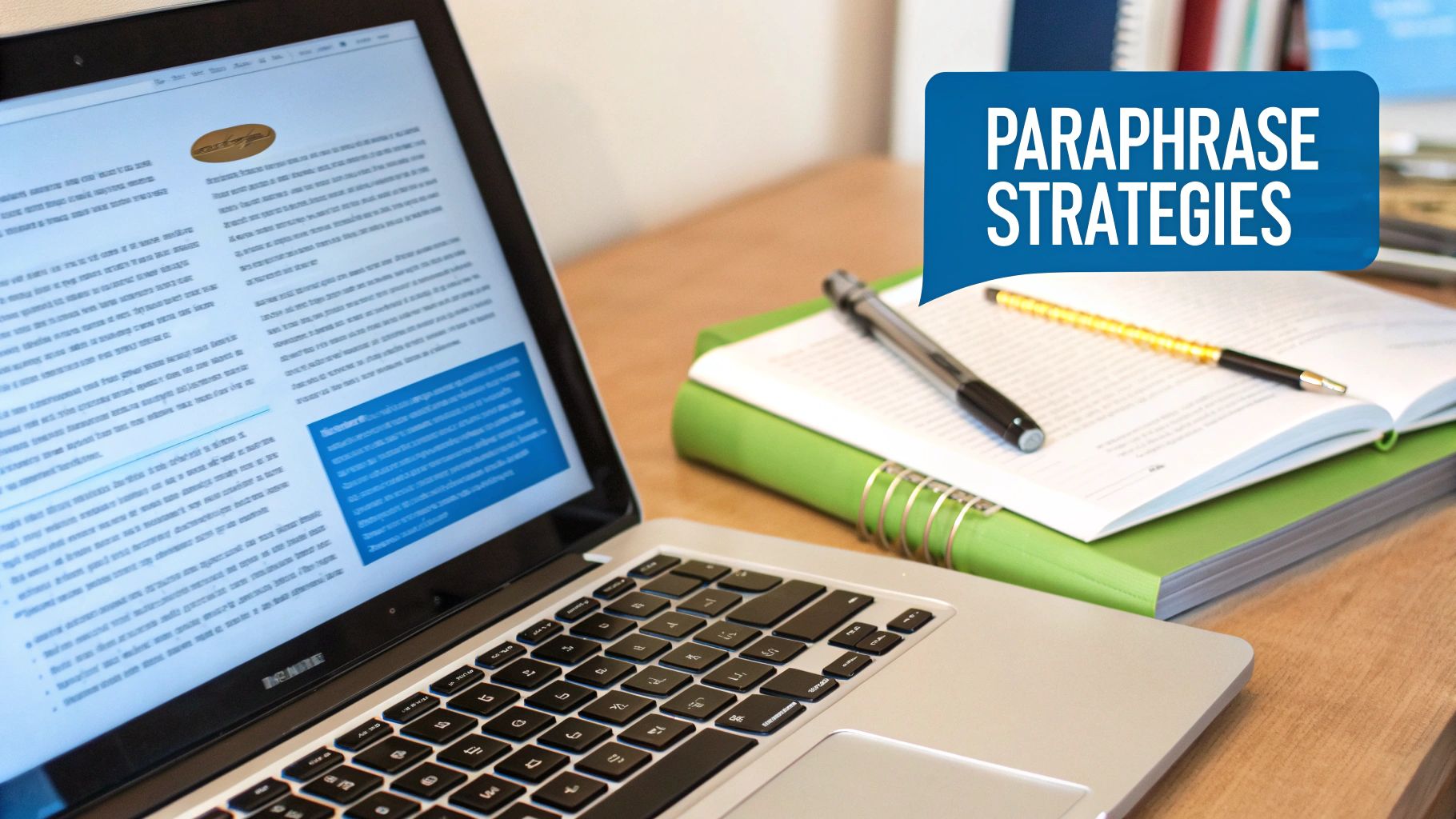
This screenshot from SmartStudi's paraphraser shows how the tool helps restructure and reword text while preserving the original meaning. Notice how it goes beyond simple synonym replacement, offering alternative phrasing that clarifies and strengthens the original idea. It's a powerful tool to get you started, but remember, human oversight is always crucial.
Mastering the Art of Restructuring and Re-Focusing
Restructuring sentences is one of the most effective paraphrasing techniques. This means playing around with word order, sentence length, and grammatical structure. You could break a long, complex sentence into several shorter ones, combine short sentences into a longer, more flowing one, or shift the emphasis from one part of the sentence to another.
Changing perspective is another powerful strategy. Maybe the original text focuses on a specific group or event. In your paraphrase, you could shift the focus to a different group or a broader trend. Even something as simple as changing the voice from active to passive (or vice versa) can significantly alter the sentence structure without affecting the core meaning.
Weaving together multiple sources seamlessly is where you really show your understanding of a topic. Rather than summarizing each source individually, synthesize the information, drawing connections and highlighting contrasting viewpoints. This demonstrates a deeper level of comprehension and allows you to build a more nuanced and compelling argument. For additional support, you might find SmartStudi’s paraphrasing tools helpful.
Self-Checking Strategies and Common Mistakes
Having a solid self-checking system is essential. Before submitting anything, review your work carefully. Look for phrases that are too close to the original sources. A great trick is to read your paraphrase aloud. This can help you catch awkward phrasing or unintentional similarities you might miss when reading silently. Ask yourself: "Have I truly transformed these ideas, or have I simply rearranged the words?"
Over-relying on synonyms is a common trap. While synonyms are useful, they don't automatically equal effective paraphrasing. Another pitfall is not rewriting enough. Just changing a few words here and there won't do it. You need to substantially alter the sentence structure and vocabulary. And finally, always, always cite your sources, even when paraphrasing. This is fundamental to academic honesty and builds trust with your readers. Master these techniques and avoid these common mistakes, and you'll be well on your way to creating original and ethical content.
Smart Technology Integration for Better Writing
Let's chat about AI paraphrasing tools. They're popping up everywhere these days, promising to make writing a breeze. But the real question is: how can you use them ethically and effectively, without accidentally plagiarizing? The secret is remembering that these tools are designed to help you, not do the work for you. They're a great starting point, like a trusty assistant, but your own human touch is still what brings it all together.
Think of AI paraphrasers like having a super helpful editor who can offer different ways to phrase things. They can be absolute lifesavers for overcoming writer's block or quickly trying out different versions of a sentence.
But just like human editors, they aren't perfect. Sometimes they can misinterpret the subtle meaning of something or suggest changes that actually distort the original point. That’s where you come in. You need to carefully evaluate the suggestions and pick the ones that truly work while making absolutely sure the meaning stays true to the original source.
It's also helpful to understand that different AI systems work differently. Some are simple synonym swappers, while others use complex neural networks to actually understand the context and create more nuanced paraphrases. Knowing these strengths and limitations helps you choose the best tool for the task at hand.
Speaking of which, SmartStudi’s paraphraser takes a balanced approach. It helps you rewrite quickly while still giving you the control to keep your own voice and the original meaning intact.
This screenshot from SmartStudi's plagiarism checker shows you how much similarity is found in a document. It pinpoints specific sections needing a closer look, which makes spotting potential plagiarism issues much easier. This visual feedback is incredibly helpful for polishing your paraphrased work. It also demonstrates how technology can be a powerful ally in upholding academic and professional integrity.
The growing demand for these kinds of tools shows how important originality and ethical content creation are becoming. The plagiarism checker software market is actually predicted to explode from $90 billion in 2023 to $153.75 billion by 2031. And it’s not just academics driving this; it's happening across all areas of digital content creation and intellectual property. Learn more about this market growth. Want to make sure your writing is polished and error-free? Check out these expert proofreading tips. Don't forget: combining technology with good old-fashioned paraphrasing techniques is the real key. SmartStudi also has a handy grammar checker you might want to explore.
By integrating these tools into your writing process, you can become more efficient and authentic. The goal is to make the technology work for you, not the other way around. Remember: you're the writer, the thinker, the creator—the AI is simply a tool in your toolkit.
Creating Your Personal Quality Control System
Even with the best paraphrasing skills, mistakes happen. That's why having a solid quality control system is so important. It’s like having a backup plan to catch any slip-ups before they become major issues. Think of it as your personal editing dream team, making sure your work is original and ethical.
This all begins with understanding where things can go wrong. The infographic below highlights three common paraphrasing traps: relying too much on synonyms, not rewriting enough, and forgetting those all-important citations.
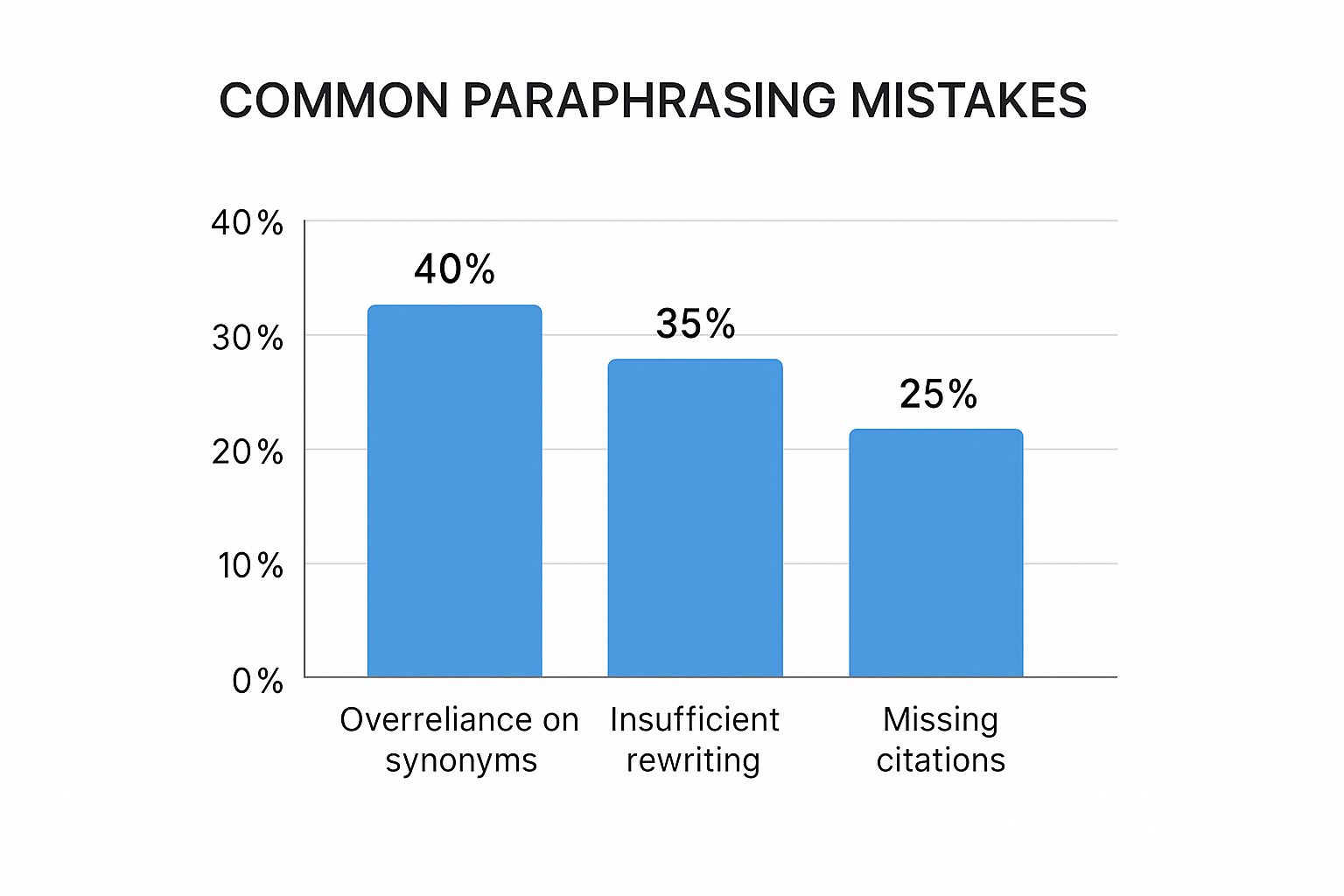
As the infographic shows, just swapping words isn't enough. A whopping 40% of paraphrasing problems come from overusing synonyms, and another 35% happen because the rewriting isn't thorough enough. Remember, good paraphrasing means restructuring and rephrasing the whole idea. And don't forget about citing your sources! A surprising 25% of mistakes are from simply leaving out the citation.
Integrating Plagiarism Detection Tools Effectively
Plagiarism checkers are incredibly useful. Tools like the SmartStudi plagiarism checker can be a game-changer in your quality control process. It's like having another set of eyes reviewing your work. But relying only on software isn’t the answer. These tools are great at catching obvious matches, but they can't understand the finer points of paraphrasing. That’s where your own judgment comes in.
Think of a plagiarism checker like a spell checker. It flags the obvious errors, but it can’t tell you if your writing is clear and engaging. Plagiarism checkers can find matching phrases, but they can’t tell you if you’ve really grasped the original idea and made it your own. You’re the one who ultimately decides if your paraphrase is accurate and adds something new. SmartStudi's citation generator can also help streamline your referencing.
Self-Auditing Techniques: Going Beyond Software
Besides using software, developing your own self-checking habits is key. One of the best things you can do is set your work aside for a bit and then come back to it with a fresh perspective. This helps you catch phrases that might be too similar to the original. Reading your work aloud is another great trick. This can help you hear awkward phrasing or echoes of the source that you might miss when reading silently.
Self-auditing also involves some serious self-reflection. Ask yourself: Have I really transformed the original idea, or just shuffled the words around? Does my paraphrase offer any new insights? These questions will help you go beyond superficial rewriting and truly understand the concepts. Ethical paraphrasing is about understanding, interpreting, and then explaining the idea in your own way.
Interpreting Plagiarism Reports and Handling False Positives
Knowing how to read plagiarism reports is also important. Sometimes, these reports flag perfectly fine phrases as potential plagiarism. These false positives often happen with common phrases or technical terms. Learning to tell the difference between a real problem and a false positive takes practice. Pay close attention to the context of the highlighted passages. If the match is a common saying or a technical term, it's probably a false positive. But if the text around the match also looks similar, you might have a real problem. This is another area where your own judgment is crucial. Getting a feel for when something needs a closer look will make your quality control process way more efficient.
Building a strong quality control system doesn’t just ensure ethical writing; it makes you a better, more confident writer. It's about trusting your judgment and knowing your work is truly your own.
To help you choose the right plagiarism detection tool, I've put together a comparison table:
Plagiarism Detection Tools Comparison
Key features and capabilities of different plagiarism detection platforms
| Tool | Detection Accuracy | Database Size | Best Use Case | Cost |
|---|---|---|---|---|
| Grammarly | High | Extensive | Students, Professionals | Freemium/Paid |
| Turnitin | Very High | Academic Databases | Education Institutions | Paid |
| Quetext | High | Large Web Database | Businesses, Writers | Freemium/Paid |
| Copyscape | Moderate | Web Pages | Website Owners | Paid |
| SmartStudi | High | Growing Academic & Web Database | Students, Researchers | Freemium/Paid |
This table highlights key features like detection accuracy and database size, helping you find the best tool for your needs. While Turnitin is a strong choice for academic work, tools like Grammarly and Quetext offer broader applications. SmartStudi is a great option for students and researchers, and Copyscape is tailored for website owners. Consider your specific needs and budget when making your decision.
Developing Your Authentic Writing Voice
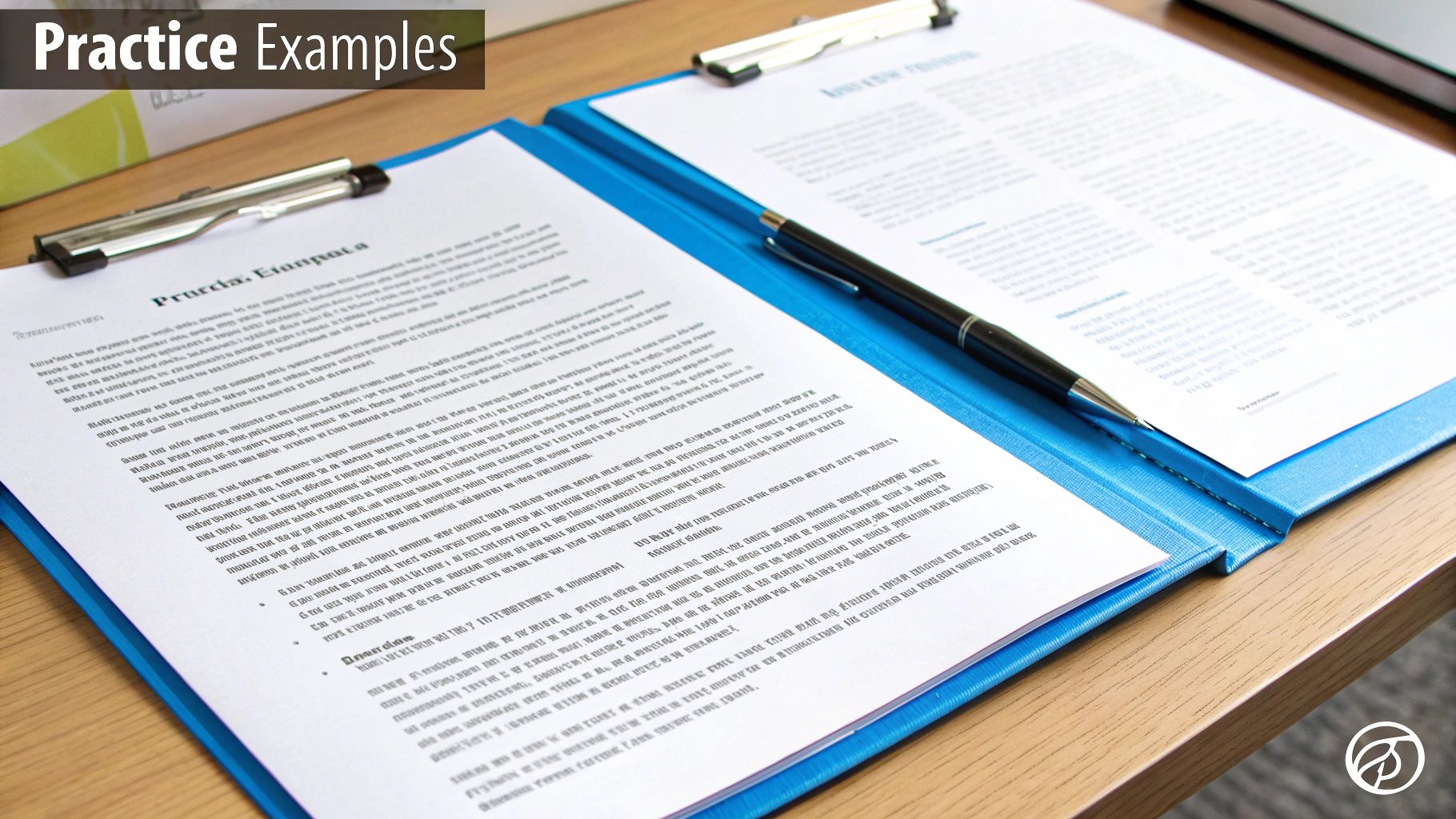
Paraphrasing well isn't just about avoiding plagiarism—it's about letting your own perspective shine through. It’s about absorbing someone else's ideas and then expressing them in a way that’s uniquely you. Think about your favorite writers—they weave research and personal insights together seamlessly, creating work that's both informative and engaging. That's what we're aiming for here: helping you develop a writing style that truly reflects your understanding.
Finding the Balance: Respecting Sources While Adding Your Own Spin
One of the trickiest parts of paraphrasing is finding that balance between giving credit where it's due and adding your own personal touch. It's similar to a good conversation—you listen to what the other person is saying, and then you respond with your own thoughts and experiences. You're not simply repeating their words; you're adding something new to the discussion.
Let's say you're writing about how social media affects teenagers. You might come across a study that shows a link between spending too much time on social media and lower self-esteem. Instead of just rehashing the study's findings, you could relate them to your own observations of how teens interact online, or maybe share a relevant personal anecdote (being mindful of privacy, of course). Adding this kind of personal touch makes your writing more relatable and keeps the reader engaged. It shows you haven't just read the research, you've actually processed it.
Practical Exercises: Building Confidence in Your Paraphrasing
A great way to improve your paraphrasing skills is to practice knowledge transformation. This means going beyond simple rewording and actually adding your own layer of meaning to the information. Try taking a dense paragraph and condensing it into a single sentence that captures the core idea in your own words. Or, try shifting the perspective of a passage, focusing on a different angle of the topic.
Another useful exercise is to weave together information from several different sources to create a new, cohesive narrative. This is where your critical thinking abilities really come into play. You’re not just reporting information; you’re synthesizing it, creating something fresh and original. These exercises not only teach you how to paraphrase ethically, they also deepen your understanding of the subject matter and help you develop a more sophisticated writing style.
Smooth Transitions: Weaving Quotes and Paraphrases Together
Creating smooth transitions between borrowed material and your own ideas can be challenging. One technique is to use signal phrases to clearly introduce the source. For instance, you could write "According to Dr. Smith," or "A recent study published in the Journal of X found that…". This clearly distinguishes the borrowed information from your own writing.
Another helpful tip is to vary your sentence structure. If the original source uses short, choppy sentences, try combining them into a longer, more flowing sentence in your paraphrase. Conversely, if the source is very formal, you could try using a more conversational style. These small shifts help differentiate your voice from the original source, resulting in a more engaging and cohesive piece of writing. Building your authentic voice is all about having confidence—confidence in your ability to understand, interpret, and communicate complex ideas in a way that is both ethical and engaging.
Your Complete Implementation Strategy
So, we've covered a lot about ethical paraphrasing. Now, how do you actually use all this information? How do you weave it into your everyday writing, whether it's a short blog post or a deep-dive research paper? It's all about building a system that works for you. Think of this as your personalized, practical roadmap to more effective and ethical writing. We’ll look at workflow ideas, practical tips, and how to stay ahead of the curve as plagiarism-detection technology advances.
Setting Up Your Writing Environment for Success
Believe it or not, your writing environment plays a huge role. A dedicated space, even if it's just a corner of your desk, can do wonders for your focus. Keep it clutter-free and minimize distractions. I personally like having separate zones for research and writing – it helps me mentally shift gears.
Having the right tools at hand also helps. A good thesaurus and a reliable style guide (Chicago Manual of Style or AP Stylebook) can be lifesavers. And as we've discussed, AI tools like SmartStudi can be incredibly valuable, especially when you’re wrestling with a tricky sentence.
Quality Control Processes that Actually Work
A solid quality control process is key for catching accidental plagiarism. Before submitting anything, double-check your work. Read it aloud. Run it through a plagiarism checker. Ask yourself the hard questions: "Have I truly transformed the source material? Does my paraphrase bring something new to the table?"
I’ve also found it helpful to keep a running log of my sources. This isn’t just good citation practice; it also helps you track how you’ve used each source. It's a simple way to stay organized and avoid unintentional slip-ups.
Handling Rush Deadlines Without Compromising Ethics
We've all been there: deadline looming, pressure mounting. It's tempting to cut corners, but trust me, it’s never worth it, especially with paraphrasing. One strategy I use is to break the project down into smaller, more manageable chunks. This makes the whole thing feel less overwhelming and helps me maintain focus on quality.
Another trick? Tackle the hardest sections first. These are often the ones that require the most intense paraphrasing, so getting them done early frees up mental energy for the rest of the assignment. Good paraphrasing skills are even more important under pressure.
Continuous Improvement and Staying Up-to-Date
The world of plagiarism detection is constantly evolving. Make it a habit to stay updated on best practices and changes to tools like SmartStudi. You might be surprised how quickly things change! Keeping your skills sharp isn’t just about avoiding penalties—it’s about becoming a better writer overall.
Ready to step up your writing game? SmartStudi offers a whole suite of AI-powered tools, from plagiarism checkers to paraphrasers, designed to help you write ethically and efficiently. Give it a try and see how it can transform your writing process.
